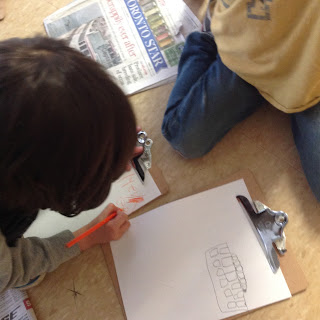Given that I firmly believe in positioning myself as a co-learner alongside the students, I want to devote this end of the school year post to my reflection on what the students taught me this year. Just as they can learn from us, we can (and should!) learn from them. They have a lot to teach, when you pay attention.
So, here are my big takeaways from the school year, thanks to the marvellous and inspiring students in Room 109:
We All Learn in Our Own Ways, In Our Own Time
I've always known this - the idea that development is a continuum in which students travel on their own trajectories, but I feel like I really understood it this year, while seeing the benefits in action. More than ever I challenged myself as a teacher to incorporate a higher amount of small group learning tailored to a more specific range of needs. Once upon a time I may have given all students a similar language task - with all of them working on the exact same criteria - but my students reminded me of the power in turning this idea upside down. From the get go, I witnessed students achieving higher levels of success in our small literacy groups. By paying closer attention to where each student was currently at, my teaching partner and I were able to present students with more individualized tasks that were within their own zone of proximal development. With this, comes not only higher success, but a far greater deal of student pride as students take note of their own mastery - which is a lovely thing to witness and oh so powerful for a Kindergarten's self image. I hope to continue this growth in my own teaching next year by not only having small language groups but also adding small math groups. I thank my students this year for reminding me of the good that can come out of re-framing how we approach group learning in the early years.
Live Without Fear
One of my favourite things about students in Kindergarten is how fearlessly they jump into everything new. While I don't recall my own specific feelings, I imagine walking into a new classroom (and your first classroom, at that!) as a new JK in September must be terrifying. But that's the thing - none of the students seem to be held back by this fear. This year I was so impressed with how the students in our room leapt head first into brand new routines, friendships, learning activities, outdoor experiences, and challenging skills. The idea of living like a Kindergarten student, without fear, really stood out to me this year and directly impacted by own practice in the following way. My teaching partner and I were thrilled this year to be invited to participate in a TDSB initiative called Kindergarten Leaders Inspiring Visions of Excellence (or Kindergarten L.I.V.E.). This incredible program brought together like minded Kindergarten educators to share ideas, develop common beliefs, and to learn from one another. Through Kindergarten L.I.V.E. I was able to welcome other teachers into our room to observe what we do and also presented my first professional development session for other teachers - things I am very proud of this year, and can also honestly say resulted in more self-growth/reflection than I ever thought possible. Yes, along the way, I may have thought once or twice "What if they don't like what I do? What if they disagree with my ideas about teaching?". However, from cues I took directly from the courage shown by the students daily, I pushed those thoughts aside and jumped right in without fear - something I am so, so thankful for after seeing the amount of professional learning that came out of it.
When It Doubt, Dance It Out
"Mr. Seaman, I think we need a dance party". These words, spoken by a JK student, reminded me how important it is to ensure moments of pure joy daily in our classrooms. Yes, students should, and do, work hard in our programs - but it should never be at the expense of their enjoyment. I am a firm believer that above all else (reading levels or amount of known sight words for example) a student should think of school as a positive and happy place. Yes, those other things are important at times, but I believe they don't serve a student nearly as well as a good outlook towards school and learning. For this reason, our class has many, many, many dance parties. Sometimes we just need it. We stop what we're doing, meet on our central community carpet, and shake it to one of many songs (turns out this year my students were big Bob Marley fans! Who knew?). What I thought was so neat this year was how the students took this idea, internalized it, and started to articulate all on their own when they thought we needed to have a dance party. When the aforementioned student said those words (I'll admit it - it was after a whole group math concept - working on this!) I really took it to heart and felt so proud of the student for this important reminder. On one of our last days this year, we had a final dance party together after an absolutely enthralling student led discussion on the feeling of "joy". After dancing our hearts out (thanks for the soundtrack Taylor Swift!), we closed our eyes and tried to describe what the joy felt like inside our bodies. I want to end the post with some of those student responses, since I think more than anything they will stay with me long after this year is gone.
"Joy feels like I am running and running"
"Joy feels like I am in nature and it's quiet and I hear birds"
"Joy feels like a party in my brain"
Thank you students for this year, it's been joyful.





















